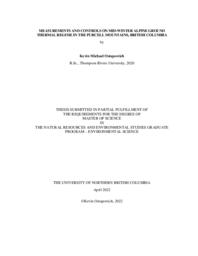Geertsema, Marten
Person Preferred Name
Marten Geertsema
Related Works
Content type
Digital Document
Description / Synopsis
The aim of this dissertation is to investigate and quantify biophysical diversity on landslides in the boreal forest of the Peace River Region of northern British Columbia (BC), sampling three landslides that occurred in the last 50 years. Landslides are increasing in the boreal forest, likely driven by climate changes such as increased precipitation and permafrost thaw, and as a derivative of large wildfires. An understanding of ecosystem recovery on landslides is important for conservation and management purposes. Several studies have been done in southern parts of the world to elucidate processes of landslide recovery. However, few studies have addressed landslide recovery in northern climates, and little is known about the biophysical diversity of landslides in this region. This research investigates whether landslides are more biophysically diverse than the surrounding relatively undisturbed terrain, and whether microsite variables or geomorphic diversity are predictors of plant community diversity. Using a series of field sampling campaigns and GIS (geographic information system) mapping exercises, I show that landslides are more biophysically diverse than the surrounding terrain in some respects, while the surrounding undisturbed terrain is more diverse in other aspects. The age and size of landslides also appear to influence diversity. Microsite diversity does not necessarily predict plant diversity. The research highlights the role of invasive plant species in slope stabilisation and plant community makeup. I also show that landslide ponds are disproportionately concentrated on rotational landslides, and that most ponds on landslides occur in the body and toe. I note post-slide modifications such as drainage of landslide ponds and lowering of landslide ridges, but many geomorphic features are expected to endure for decades to millennia. Overall, the research shows that vegetation recovery is complex and may take decades to fully manifest. This study contributes knowledge about plant community and site diversity on landslides by providing quantitative data and comparing those traits with those found on surrounding terrain. These findings can be used as guidance when identifying conservation and management practices for ecological restoration of disturbed slopes.
Origin Information
Content type
Digital Document
Description / Synopsis
Alpine snow is an important water reservoir for mountain hydrology, climate, ecosystem functions, and has substantial economic value. Snowmelt during spring and summer is driven primarily by incoming shortwave and longwave radiation fluxes, and the ground heat flux is considered to be negligible during this time. However, during the accumulation phase, the ground heat flux may contribute to snowpack thermal conditions and midwinter melt, though this subject has not been studied extensively. The objective of this study is to quantify the alpine ground thermal regime and its relation to topographic setting and the overlying snowpack. The effects of elevation, maximum winter snow depth, snow cover duration, slope, ruggedness, aspect, total potential solar radiation, proximity to glacial ice, and depth of thermistor were evaluated. Four transects consisting of 29 temperature data loggers at the ground-snow interface and one meteorological station collected data from 16 August 2020 to 6 August 2021 at an alpine site in the Purcell Mountains in British Columbia. Snow cover duration, onset, and end-of-winter depths were found to have the greatest influence on the ground thermal regime. Total potential solar radiation had an inverted relation with ground temperatures, however, this was likely related to snow cover duration. Modeled ground heat flux scenarios revealed that snow depth or onset is the most influential of the variables tested. Snow thermal conductivity has the second greatest influence on total ground heat flux, however, true snow thermal conductivity likely varies throughout the winter season and was not measured in this study. Wind has the greatest influence on snow distribution within the Conrad basin with wind scoured slopes coincidentally sharing the same aspect as slopes that receive the greatest total potential solar radiation. There is little evidence to suggest that the ground thermal regime has any influence over the overlying snowpack.
Origin Information


